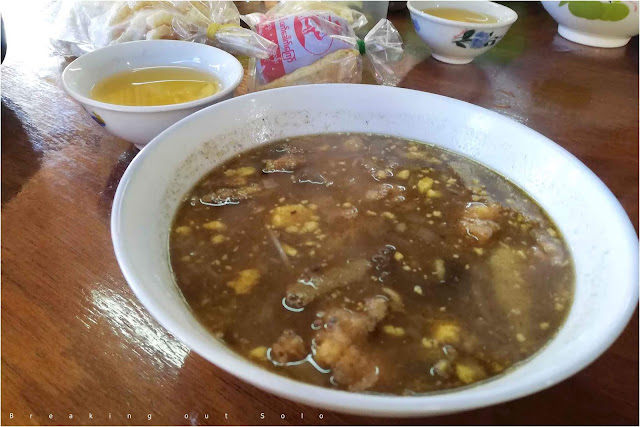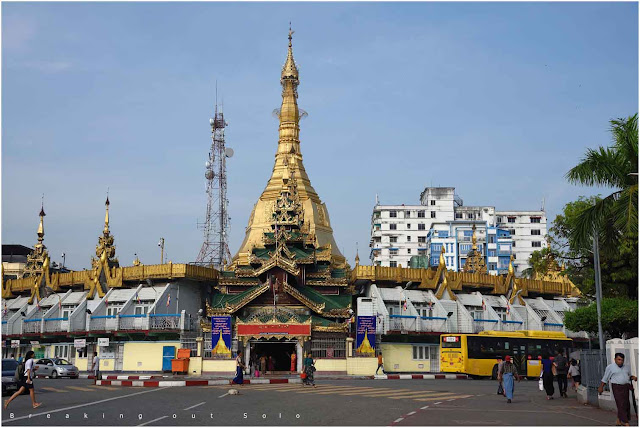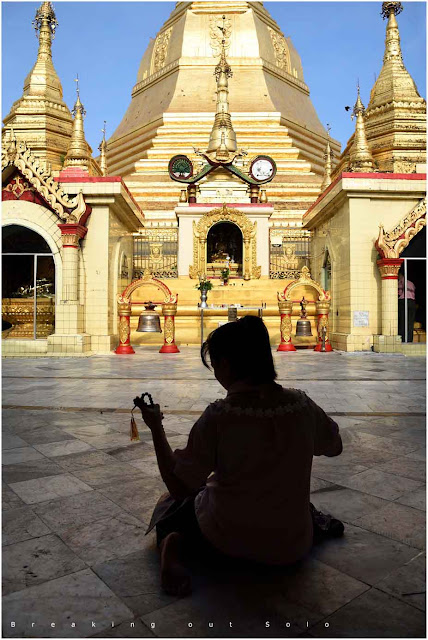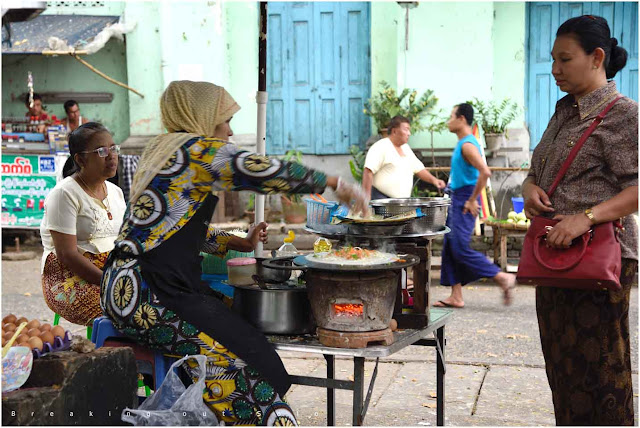Rested in my nicely air-conditioned room, I woke early ready for my first day in Yangon. I specifically mention the air-conditioning as without it, the room would have been extremely stuffy and uncomfortable. The windows were sealed shut but the streets of Myanmar can be noisy and dusty. It was probably a desperate attempt by the hotel.
In the very short time that I had to plan the trip, I was unable to schedule my individual days and had decided to just wing it. Before going to bed the previous night, I had talked to the landlady about it and also ran through the 'Things to do in Yangon' list. This had given me a tentative idea about what I was going to do through the day. But first, I needed breakfast.
Read the previous posts from Yangon
"Mingalaba" Myanmar - Part I | The Arrival
Yangon Circular Railway
The lovely lady at the hotel had asked if I would like to try a traditional breakfast. It was included in the room price. How could I say no to that. The dish in question was mohinga. It's noodles served in a fish based soup with a number of ingredients as toppings. The interesting part of this dish is, despite the presence of fish, I did not get the fishy smell at all. Mohinga is available at all hours of the day in every corner of Myanmar. No wonder it is considered to be Myanmar's national dish and became my favourite.
Food is a big part of the Myanmar culture as is there spirituality, something I would come to realise through my stay.
The 44m high octagonal golden spire of Sule pagoda stands as a prominent landmark of downtown Yangon. Legend has it that the original pagoda was built during the lifetime of Buddha over 2,600 years ago. The present structure of the pagoda came around the 15th century. It was during the British rule that the city was redesigned and Sule became the centre of downtown Yangon. The pagoda enshrines a hair relic and is held in high reverence by the Buddhists. While entrance is free for locals, foreigners have to pay 5,000 kyat. Shoes are to be left outside, and hence along with the payment receipt I received a freshening towel to wipe my feet clean before putting back the shoes.
I spent some time at the pagoda, first paying my respect and then just observing the locals. They came dressed in office wear and school uniforms to offer their prayers before starting out with their day. As I said before, spirituality is ingrained deep in this predominantly Buddhist country.
I was greeted by a young man claiming to be a student and willing to practice his English. He wanted to show me around Yangon. No price was quoted. But since I had my own relaxed plans, I had to decline politely. Later, another young man approached me inside the pagoda with a similar proposal Probably this was a thing among the locals. However, they were not persuasive and gracefully accepted my apologies.
I walked out of the park to reach a much older part of Yangon. Rows of colonial era buildings, some derelict while others retaining their character looked down the narrow lanes. Hawkers stalls lined up were busy with people gathered for food and chat. Everyone looked happy, making me realise once more the significance of food in the Myanmar culture.
Yangon was reminding me so much of my hometown Kolkata. Both the cities have had a similar history, having being under the British rule and both a capital city. There have been many visitors to the erstwhile Rangoon from Bengal, and there must have been an intermingling of culture. It all felt very familiar.
I was hot, thirsty and hungry when I exited the station and headed into the first convenience store I came across. Even before I had paid for it, I had gulped down almost a litre of chilled water. It was time to find food. Searching on the net, the 999 Shan Noodle shop came up as a top option in my vicinity. Glad I had purchased the local sim card earlier. I headed for a slow, late lunch. The popular shop is in a street with some interesting buildings and had a substantial percentage of western visitors. The food was cheap. I ordered a noodle soup that cost me something around 1000 kyat.
I was following the Sule pagoda road to the Yangon night market. As I passed each narrow lane crisscrossing the main road, my senses was assaulted by a multitude of sight, sound and smell. The demographic was changing as well, as I found myself walking through Muslim neighbourhoods. Road side stalls were selling food ranging from dosa, pakora, samosa and biryani. It definitely was a hotpot of cultural mix.
I gradually reached a quieter part of the town when I heard someone speaking in what sounded like Cantonese on the phone. I figured I was close to China Town.
As the sun started to set, I could see the night market on the opposite side of the busy wide road. The market appeared very quiet, probably still being set up for the evening. Without a pedestrian crossing in sight, as with many roads of Yangon, I was not willing to put the effort of trying to cross through rushing traffic. I was tired and too early for the market. Decided to call it a day and headed back, but not before I had stopped for some night shots of the Sule pagoda.
Next morning I was going to visit the famed Shwedagon pagoda. As I went to bed, was still speculating whether to go for a sunrise visit. My first day in Yangon had already drained me of all my energy. After my train ride on the circular railway, I was feeling very overwhelmed and was starting to seriously doubt my decision to spend two days in Yangon. However, walking the streets of Yangon in the afternoon had changed my perspective and I found myself gradually warming up to the city.
My post on the Facebook page that night, a moment from the circular railway journey.
Follow for more travel posts.
In the very short time that I had to plan the trip, I was unable to schedule my individual days and had decided to just wing it. Before going to bed the previous night, I had talked to the landlady about it and also ran through the 'Things to do in Yangon' list. This had given me a tentative idea about what I was going to do through the day. But first, I needed breakfast.
Read the previous posts from Yangon
"Mingalaba" Myanmar - Part I | The Arrival
Yangon Circular Railway
The lovely lady at the hotel had asked if I would like to try a traditional breakfast. It was included in the room price. How could I say no to that. The dish in question was mohinga. It's noodles served in a fish based soup with a number of ingredients as toppings. The interesting part of this dish is, despite the presence of fish, I did not get the fishy smell at all. Mohinga is available at all hours of the day in every corner of Myanmar. No wonder it is considered to be Myanmar's national dish and became my favourite.
Sule Pagoda
Post breakfast, I set out to visit the Sule pagoda, a short walk from my hotel. I needed a local sim, but the shops were not yet open. I went past quite a few makeshift eateries set up on the pavement serving mohinga and other noodle items, everything secured from the dust and pollution by plastic tents. Young boys and girls, wearing the traditional longyi were seated on short stools gathered around these eateries, chatting and laughing.Food is a big part of the Myanmar culture as is there spirituality, something I would come to realise through my stay.
The 44m high octagonal golden spire of Sule pagoda stands as a prominent landmark of downtown Yangon. Legend has it that the original pagoda was built during the lifetime of Buddha over 2,600 years ago. The present structure of the pagoda came around the 15th century. It was during the British rule that the city was redesigned and Sule became the centre of downtown Yangon. The pagoda enshrines a hair relic and is held in high reverence by the Buddhists. While entrance is free for locals, foreigners have to pay 5,000 kyat. Shoes are to be left outside, and hence along with the payment receipt I received a freshening towel to wipe my feet clean before putting back the shoes.
I spent some time at the pagoda, first paying my respect and then just observing the locals. They came dressed in office wear and school uniforms to offer their prayers before starting out with their day. As I said before, spirituality is ingrained deep in this predominantly Buddhist country.
I was greeted by a young man claiming to be a student and willing to practice his English. He wanted to show me around Yangon. No price was quoted. But since I had my own relaxed plans, I had to decline politely. Later, another young man approached me inside the pagoda with a similar proposal Probably this was a thing among the locals. However, they were not persuasive and gracefully accepted my apologies.
Old Yangon
A variety of old and new structures surround the area around Sule pagoda. The most prominent are the Yangon city hall and the Mahabandula park. The sun was already starting to get hot and it was barely 9am. Through the park, I walked past the massive obelisk of the Independence monument where a party of pre-wedding shoot photographers were trying to make a very awkward couple pose intimately.I walked out of the park to reach a much older part of Yangon. Rows of colonial era buildings, some derelict while others retaining their character looked down the narrow lanes. Hawkers stalls lined up were busy with people gathered for food and chat. Everyone looked happy, making me realise once more the significance of food in the Myanmar culture.
Yangon was reminding me so much of my hometown Kolkata. Both the cities have had a similar history, having being under the British rule and both a capital city. There have been many visitors to the erstwhile Rangoon from Bengal, and there must have been an intermingling of culture. It all felt very familiar.
Yangon Circular Railway
I had planned to walk to the Yangon Central Railway station to visit its distinct looking building. My original intention was to ride the 46km circular railway, not only to have a glimpse of rural Yangon, but also to escape the heat. The sun was raging on Yangon by now. However, the railway line was undergoing renovation and was partly closed. I eventually took a ride on the train. Even though it was not up to my expectations, it still was an amazing place for people watching. You can read about the journey on this post - Yangon Circular RailwayI was hot, thirsty and hungry when I exited the station and headed into the first convenience store I came across. Even before I had paid for it, I had gulped down almost a litre of chilled water. It was time to find food. Searching on the net, the 999 Shan Noodle shop came up as a top option in my vicinity. Glad I had purchased the local sim card earlier. I headed for a slow, late lunch. The popular shop is in a street with some interesting buildings and had a substantial percentage of western visitors. The food was cheap. I ordered a noodle soup that cost me something around 1000 kyat.
Streets of Yangon
Energised, it was time to hit the roads again. This time, my destination was China Town for the night market. The landlady at my hotel had advised me to go there early evening as she did not think I would feel safe later in the night. I could not imagine Yangon to be unsafe given my experience through the day, but it is always sensible to listen to local advice.I was following the Sule pagoda road to the Yangon night market. As I passed each narrow lane crisscrossing the main road, my senses was assaulted by a multitude of sight, sound and smell. The demographic was changing as well, as I found myself walking through Muslim neighbourhoods. Road side stalls were selling food ranging from dosa, pakora, samosa and biryani. It definitely was a hotpot of cultural mix.
I gradually reached a quieter part of the town when I heard someone speaking in what sounded like Cantonese on the phone. I figured I was close to China Town.
As the sun started to set, I could see the night market on the opposite side of the busy wide road. The market appeared very quiet, probably still being set up for the evening. Without a pedestrian crossing in sight, as with many roads of Yangon, I was not willing to put the effort of trying to cross through rushing traffic. I was tired and too early for the market. Decided to call it a day and headed back, but not before I had stopped for some night shots of the Sule pagoda.
A traditional Burmese dinner
Back at the hotel, showered and refreshed, I was looking for food. The landlady had recommended some Indian restaurants, but I was adamant on going local. She suggested I visit one serving Burmese food. I forget the name of the place, but it was my first introduction on how to order food in Myanmar. I only needed to order the main dish, like meat or fish and my table was set up with a multitude of side dishes along with the rice. There is always a salad where a raw vegetable, egg plants on this occasion, makes an appearance which is to be had with a strong tasting fish sauce called ngapi. The food here was one of the more expensive ones I had in Myanmar costing me about 8000 kyat. But it also included three main dishes.Next morning I was going to visit the famed Shwedagon pagoda. As I went to bed, was still speculating whether to go for a sunrise visit. My first day in Yangon had already drained me of all my energy. After my train ride on the circular railway, I was feeling very overwhelmed and was starting to seriously doubt my decision to spend two days in Yangon. However, walking the streets of Yangon in the afternoon had changed my perspective and I found myself gradually warming up to the city.
My post on the Facebook page that night, a moment from the circular railway journey.
Follow for more travel posts.





























No comments:
Post a Comment
A blog is not a blog without comments. So, please do leave your thoughts...thank you! :-)